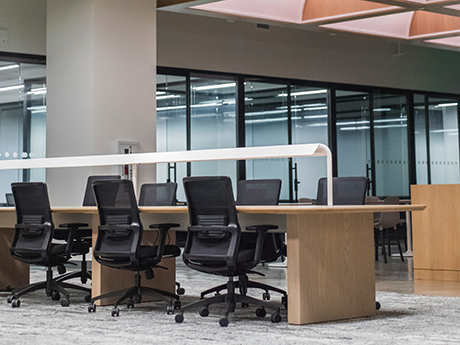Economic headwinds such as elevated interest rates and persistent inflation led to mixed outcomes in the first quarter for industrial, office, retail and multifamily sectors, with market observers anticipating a contracting economy, as outlined by Lee & Associates’ 2024 Q1 North America Market Report.
On the industrial front, market pressures — including interest rates and supply chain challenges — led to higher vacancy in the United States in the first quarter of the year.
U.S. office space experienced its fifth consecutive year of contraction, as office worker attendance stagnated. Additional challenges, in the form of loans maturing in a high-rate environment, signal further challenges in the near future for the office landscape.
Continued merchant demand, reduced closures and bankruptcies and limited supply converged to create a feeding frenzy for retail space, with vacancies at historic lows.
And finally, geographically based factors drove multifamily markets, many of which (especially in the Midwest and Northeast) experienced a rebound in apartment demand fueled by rising consumer sentiment and moderating inflation, despite supply outpacing demand.
Lee & Associates has made their full, first-quarter report available here (with breakdowns of cap rates by city, vacancy rates, market rents, inventory square footage and more). The summaries from each sector below provide an in-depth look at each property type’s path forward in 2024.

Industrial Overview: Market Pressures Shape Industrial Growth
Interest rate hikes by central banks aiming to tame inflation and tenants battling supply chain and other issues continue to slow industrial demand across the United States and Canada.
One difference between the two neighbors, though, is consumer behavior on discretionary spending. When Canadians shut their wallets as the Bank of Canada began raising rates in 2022, the buying habits of U.S. households hardly changed. The Commerce Department reported that Americans closed out 2023 with a 2.8 percent increase in personal consumption spending.
Fortunately, the relative overall health of labor markets, household incomes and business margins have most observers expecting only cooling but not contracting economies. But a 12-year low in U.S. home purchases hit the sales of furniture, appliances and building materials. Bed, Bath & Beyond closed 360 locations. HomeGoods, Home Depot and tile maker Daltile closed distribution centers larger than 500,000 square feet in the first quarter of this year. On the plus side, Burlington Coat Factory, TJX Companies, Chuck and Dwight and Nestle USA all have signed leases larger than 700,000 square feet this year.
Tampa, Jacksonville, Lehigh Valley and Detroit have bucked the national trend by recording tightening availability rates over the past 12 months. Speculative construction in Lehigh Valley and Detroit have gained from the growth of manufacturing tenants and distributors. Jacksonville and Tampa have been direct beneficiaries of diverted Asian imports through the Panama Canal to East Coast and Gulf Coast ports.
The catastrophic collapse of Baltimore’s Francis Scott Key Bridge on March 26 disrupted shipping schedules and upended logistics up and down the East Coast. The U.S Army Corps of Engineers said a channel to the port would be open by the end of April with full access by late May.
Container traffic through the ports of Los Angeles and Long Beach appears to have bounced back in early 2024 following ratification of a six-year labor agreement by dockworkers in September. Volumes through the San Pedro Bay port complex had been falling from their 2021 peak. A top executive of the Port of Los Angeles recently said that first-quarter volumes were expected to increase as much as 25 percent compared to last year.
The first-quarter vacancy rate in the U.S. was 6.2 percent, climbing from 3.9 percent in mid-2022. Despite a raft of new buildings scheduled for completion, vacant space is not expected to exceed its 20-year average of 7.1 percent. Some 391 million square feet are underway across 87 markets, beating the prepandemic three-year average of 302 million square feet.

Office Overview: U.S. Contraction in Its Fifth Year
First-quarter net absorption of office space in the United States was negative 26.8 million square feet, as the COVID correction continued into its fifth year. Office attendance has been stagnant, and by most broad measures, workers across the U.S. generally are in the office about half as much as pre-COVID.
Despite a strong economy and job growth, cost-cutting has been a theme in recent corporate earnings reports. Underutilized office space has been viewed as an opportunity for savings.
The first-quarter vacancy rate in the U.S. increased to 13.8 percent, from 13.5 percent at the end of 2023. There was 60.7 million square feet of negative net absorption in 2023, the fourth straight year with growth in the red. Since the pandemic struck in the first quarter of 2020, vacant space in the U.S. has increased 275.9 million square feet as return-to-office initiatives have failed to gain traction.
Cumulatively, the amount of occupancy lost since 2020 is four times what was recorded during the Great Recession and three times greater than the dot-com bust in 2001. Although down somewhat from the peak in mid-2023, there are 203 million square feet available for sublease, over half of which are vacant. Second-hand space is nearly twice the total at the end of 2019.
Newly completed buildings have seen consistently higher rates of absorption. Nevertheless, the 3.3-billion-square-feet inventory of Class A posted 13.2 million square feet of negative net in the first quarter of 2024. That comes on the heels of 29.2 million square feet of negative net absorption in 2023 for premium space. Older properties generally are unable to retain tenants. In many markets, buildings from 3 to 10 years old are struggling. Sublease availability at these properties has increased from about 1.5 percent in 2019 to more than 6 percent.
Construction starts fell to 32 million square feet in 2023, the least since the 30 million square feet started in 2010. There are now only about 101 million square feet under construction, the least in more than a decade and off nearly 40 percent from the 2020 peak.
The implications for property values are sobering. Since the end of 2021, average office values are down 12-15 percent. For larger, institutional-grade buildings, the decline is often twice as steep and on a par with declines during the Great Recession. With higher vacancy and deteriorating rents expected, the forecast calls for further declines until the second half of 2025.
A steady stream of low-rate loans maturing into a high-rate environment will provide added impetus for repricing, though contractual extensions and workouts should keep the pace slow. Nevertheless, debt maturities pose challenges for 2024 with about $206 billion in office loans maturing this year and $180 billion in 2025 and 2026. With delinquency rates at 7.4 percent, there is a possibility that next year the dunning will exceed the 10.5 percent delinquency rate reached following the 2008 recession.
Retail Overview: Continued Demand Produces Most Competitive Markets on Record
Prolonged merchant demand for space, fewer store closures and bankruptcies and a limited available supply have combined to produce the frothiest retail market on record in the United States, as vacancies reach all-time lows.
The U.S. vacancy rate settled at 4.1 percent at the end of the first quarter, up slightly from 4 percent at the close of 2023. Demand for U.S. retail space rose by more than 53 million square feet in 2023, the third straight year of growth. Since early 2020, there has been more than 175 million square feet of net expansion. At the close of 2023 only 4.8 percent of retail space was available, the lowest level on record.
Most of the growth in demand for space has been driven by tenants from food-and-beverage, discount, off-price and experiential sectors, which accounted for more than half of all new leasing activity over the past year. Retail tenants in the food-and-beverage sector accounted for nearly 20 percent of all leasing activity last year. The bulk of leasing activity is concentrated in spaces of 3,000 square feet or less and overwhelmingly driven by growth from quick-service restaurants. Leading tenants Starbucks, Crumbl Cookies, Yum Brands and Restaurant Brands International (which owns Burger King), Tim Hortons, Popeyes and Firehouse Subs, all signed for dozens of new locations over the past year.
Demand for medium-to-larger spaces chiefly has been driven by Dollar Tree, Dollar General, Five Below, TJ Maxx, Burlington and Ross. But lately there have been some substantial failures in the discount category: The four-decade-old 99 Cents Only stores with 14,000 employees announced it was closing all 371 stores in California, Arizona, Nevada and Texas. Dollar Tree of Chesapeake, Virginia, said it would close 600 of its Family Dollar stores and expected to close an additional 370 stores.
Merchants leased up 205 million square feet in 2023, the least since 2000, but the decline appears to be more about the lack of supply than slowing demand. The median length of time to lease available space was slightly less than eight months, the fastest since 2008. New development remains minimal. Less than 50 million square feet of new space was delivered in the U.S. last year, which is 35 percent less than the average of the last 10 years.
While moderating from the multi-decade high pace reached near the end of 2022, asking rents continue to increase at a healthy clip. Asking rents are up 3 percent over the last year to a new high of $25 per square foot. Rent increases have been strongest in Sun Belt markets, which are posting the greatest growth in population and buying power. On the flip side, rents continue to reprice downward in older B and C properties and in large urban centers with a reliance on daytime office workers.

Multifamily Overview: Geographic Considerations Drive Multifamily Markets
Rising consumer sentiment and moderating inflation have fueled a timely overall rebound in United States apartment demand. Nevertheless, supply outpaced demand for the ninth straight quarter, but that is set to change.
In the U.S., healthy net absorption of 423,409 units in the last five quarters, including the first quarter of 2024, was overwhelmed by 724,942 new apartments added to the supply. During the same period the nationwide vacancy rate has risen from 6.5 percent to 7.8 percent.
There are 20 percent fewer completions scheduled in 2024. The 142,219 apartments added in the first quarter followed the record high in annual deliveries of 582,723 units in 2023. Nationally, the forecast shows rent growth acceleration for the first time since 2021 and positive rent growth returning to all but a few markets by the end of 2024.
At the market level, nine of the 10 strongest rent growth metros in 2023 were in the Midwest and Northeast. But rents rose fastest in Orange County, California, up 3.9 percent year over year, followed by Louisville, Kentucky, Northern New Jersey, Cincinnati and Chicago at 3 percent. Houston, Miami, Memphis, Oklahoma City and Tucson were the only five major Sun Belt markets to post positive year-over-year rent growth at the end of 2023 as Sun Belt markets largely reported significant overall slowing in rent growth and demand. Many markets experienced falling rents, including Austin and Orlando at 5.1 percent and 4.8 percent respectively.
Major markets with lower 2023 overall vacancy and where vacancy was less than the 7.6 percent national rate were: San Jose at 5.2 percent, San Francisco and Louisville at 6.4 percent, Norfolk at 6.6 percent and East Bay at 7.2 percent.
Markets in the Midwest and Northeast avoided the sharp reversal of rent growth seen in Sun Belt locations as their construction pipelines remained modest during the pandemic. Projected deliveries in the Midwest in 2024 are only 5,500 units more than in 2019, compared to 67,000 units in the Sun Belt. But broad variations nationally in rent performance across markets are likely to continue this year.
— Lee & Associates Research Department. Lee & Associates is a content partner of REBusinessOnline. To read all of the 2024 Q1 North America Market Report, click here.
Retail photo by No Revisions on Unsplash.


